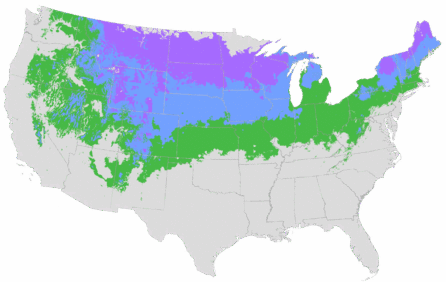You're growing in this Zip Code:
Change LocationDiscover Plants for Your Area
Northern Bayberry
Myrica pennsylvanica
We no longer grow this plant
Be Inspired: How to Use this Plant
| Bloom Time | Inconspicuous; prized for foliage. |
|---|---|
| Deciduous/Evergreen | Evergreen |
| Special Features | Ornamental Berries, Waterwise, North American Native, Compact Form, Benefits Birds |
| Problems/Solutions | Coastal Exposure, Deer Resistant, Very Wet Areas |
| Growth Rate | Moderate |
| Growth Habit | Rounded |
| Landscape Use | Privacy Screen |
| Design Ideas | Fragrant foliage can be sheared to release more scent. Popular in formal and wild gardens. A big bushy shrub, it can be used as a single specimen or ganged into a low-maintenance hedge. Perfect for transition areas between cultivated garden and native ecosystems. |
| Flower Color | Green |
| Foliage Color | Green |
| Companion Plants | Kinnikinick (Arctostaphyllus ); Oregon Grape Holly (Mahonia); Potentilla (Potentilla); Cranberry Bush (Viburnum); Magnolia (Magnolia) |
| Care Instructions | Follow a regular watering schedule during the first growing season to establish a deep, extensive root system. May be watered deeply, less frequently, when established. Feed with a general purpose fertilizer before new growth begins in spring. For a tidy, neat appearance, shear annually to shape. |
| Lore | This is a diecious plant with berries held more densely on female clones. The white waxy coating on the small fruits is used for candle making. |
| Bloom Time | Inconspicuous; prized for foliage. |
|---|---|
| Deciduous/Evergreen | Evergreen |
| Special Features | Ornamental Berries, Waterwise, North American Native, Compact Form, Benefits Birds |
| Problems/Solutions | Coastal Exposure, Deer Resistant, Very Wet Areas |
| Growth Rate | Moderate |
| Growth Habit | Rounded |
We no longer grow this plant
We no longer grow this plant
Buy Online
This plant is not available to purchase online.
We no longer grow this plant. For replacement suggestions, check out the plants “You May Also Like” below.
About Us
We have been pioneers and craftsmen in the art of growing plants for nearly
100 years. Since our founding in Southern California by Harry E. Rosedale, Sr.
in 1926, we have been absolutely dedicated and obsessed with quality.
We have been pioneers and craftsmen in the art of growing plants for nearly 100 years. Since our founding in Southern California by Harry E. Rosedale, Sr. in 1926, we have been absolutely dedicated and obsessed with quality.







